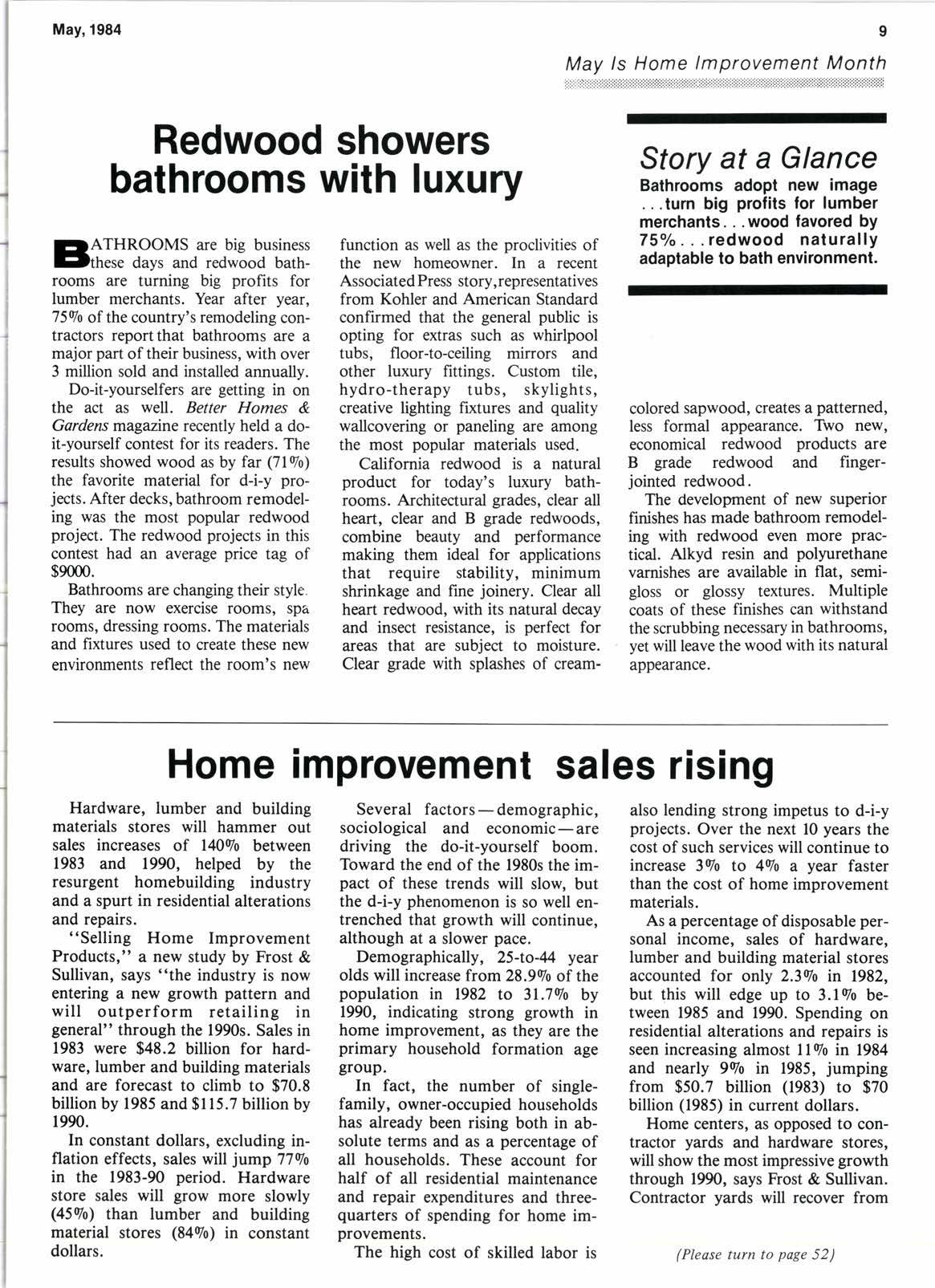
2 minute read
Home
function as well as the proclivities of the new homeowner. In a recent Associated Press story, representatives from Kohler and American Standard confirmed that the general public is opting for extras such as whirlpool tubs, floor-to-ceiling mirrors and other luxury fittings. Custom tile, hydro-therapy tubs, skylights, creative lighting fixtures and quality wallcovering or paneling are among the most popular materials used.
California redwood is a natural product for today's luxury bathrooms. Architectural grades, clear all heart, clear and B grade redwoods, combine beauty and performance making them ideal for applications that require stability, minimum shrinkage and fine joinery. Clear all heart redwood, with its natural decay and insect resistance, is perfect for areas that are subject to moisture. Clear grade with splashes of cream-
Story at a Glance
Bathrooms adopt new image ...tum big profits for lumber merchants. .wood favored by 75o/o.. redwood naturally adaptable to bath environment.
colored sapwood, creates a patterned, less formal appearance. TWo new, economical redwood products are B grade redwood and fingerjointed redwood.
The development of new superior finishes has made bathroom remodeling with redwood even more practical. Alkyd resin and polwrethane varnishes are available in flat, semigloss or glossy textures. Multiple coats of these finishes can withstand the scrubbing necessary in bathrooms, ' yet will leave the wood with its natural appearance.
Improvement Sales Rising
Hardware, lumber and building materials stores will hammer out sales increases of 14090 between 1983 and 1990, helped by the resurgent homebuilding industry and a spurt in residential alterations and repairs.
"Selling Home Improvement Products," a new study by Frost & Sullivan, says "the industry is now entering a new growth pattern and will outperform retailing in general" through the 1990s. Sales in 1983 were $48.2 billion for hardware, lumber and building materials and are forecast to climb to $70.8 billion by 1985 and $l15.7 billion by 1990.
In constant dollars, excluding inflation effects, sales will jump 7790 in the 1983-90 period. Hardware store sales will grow more slowly (45V0) than lumber and building material stores (8490) in constant dollars.
Several factors-demographic, sociological and economic-are driving the do-it-yourself boom. Toward the end of the 1980s the impact of these trends will slow, but the d-i-y phenomenon is so well entrenched that growth will continue, although at a slower pace.
Demographically, 25-to-44 year olds will increase from 28.990 of the population in 1982 to 31.70/0 by 1990, indicating strong growth in home improvement, as they are the primary household formation age group.
In fact, the number of singlefamily, owner-occupied households has already been rising both in absolute terms and as a percentage of all households. These account for half of all residential maintenance and repair expenditures and threequarters of spending for home improvements.
The high cost of skilled labor is also lending strong impetus to d-i-y projects. Over the next l0 years the cost of such services will continue to increase 3s/o to 490 a year faster than the cost of home improvement materials.
As a percentage of disposable personal income, sales of hardware, lumber and building material stores accounted for only 234/o in 1982, but this will edge up to 3.1q0 between 1985 and 1990. Spending on residential alterations and repairs is seen increasing almost I l9o in 1984 and nearly 9t/o in 1985, jumping from $50.7 billion (1983) to $70 billion (1985) in current dollars.
Home centers, as opposed to contractor yards and hardware stores, will show the most impressive growth through 1990, says Frost & Sullivan. Contractor yards will recover from










